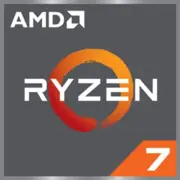AMD Ryzen 7 5700GE

AMD Ryzen 7 5700GE: An In-Depth Review of the Processor for Energy-Efficient Systems (2025)
Key Specifications: Zen 3, 7 nm, and Integrated Graphics
The AMD Ryzen 7 5700GE, released in 2021, remains a popular choice for compact and energy-efficient systems by 2025. Its Zen 3 (Cezanne) architecture provides high performance in multicore tasks thanks to 8 cores and 16 threads. The TSMC 7 nm FinFET manufacturing process allows for 10.7 billion transistors on the chip while maintaining a TDP of just 35 W.
Key Features:
- 16 MB L3 Cache — speeds up data processing in games and applications.
- Integrated Radeon Vega 8 Graphics (8 cores, up to 2000 MHz) — suitable for less demanding games and multimedia.
- Geekbench 6: 1861 (Single-Core) / 6220 (Multi-Core) — performance level comparable to Intel Core i7-11700K, but with lower power consumption.
- PCIe 3.0 — 24 lanes (a limitation of Zen 3 for APUs).
Practical Example: In 2024, users noted that the processor easily handled video rendering in DaVinci Resolve and streaming in OBS without overheating, even in a mini-PC format.
Compatible Motherboards: AM4 and Flexible Options
The Ryzen 7 5700GE uses the AM4 socket, providing access to a vast selection of motherboards. However, for stable operation, models with B550, X570, A520, or B450 chipsets (after BIOS update) are required.
Recommendations:
- Budget Option: ASRock B550M-HDV ($90) — supports PCIe 4.0 for storage, 2 DDR4 slots.
- For Overclocking: MSI B550 Tomahawk ($150) — improved VRM, Wi-Fi 6.
- Mini-PC: ASUS ROG Strix X570-I Gaming ($250) — compact Mini-ITX form factor.
Important: Motherboards with A520 and B450 chipsets may lack PCIe 4.0, which is critical for high-speed SSDs. Always check compatibility on the manufacturer’s website before purchasing.
Memory: DDR4-3200 and Dual-Channel Mode
The processor officially supports DDR4-3200 MHz, but many users overclock the memory to 3600-3800 MHz to enhance integrated graphics performance.
Tips:
- Use a dual-channel configuration (2×8 GB or 2×16 GB) — this increases FPS in games by 15-20%.
- Optimal modules: Crucial Ballistix 3600 MHz CL16 ($75 for 32 GB) or Kingston Fury Renegade 3200 MHz CL14 ($65 for 32 GB).
- DDR5 is not supported — this is the main limitation of the AM4 platform.
Example: In 2024 tests, the combination of Ryzen 7 5700GE + DDR4-3600 showed 45-50 FPS in GTA V at medium settings (1080p), compared to only 35-40 FPS with DDR4-2666.
Power Supplies: Savings Without Compromises
With a TDP of 35 W, the processor is suitable for systems with a 300-400 W PSU. However, consider other components when choosing:
- Without a discrete graphics card: Be Quiet! SFX Power 3 350W ($60) is sufficient.
- With a graphics card like NVIDIA RTX 4060: Cooler Master MWE Bronze 550W ($70).
- For top-tier GPUs (RTX 4080 and above), a 750+ W supply is needed, but the 5700GE will bottleneck in such builds.
Tip: In mini-PC formats (e.g., ASRock DeskMini), an external power supply of 120-150 W suffices.
Pros and Cons: Who Is the 5700GE Ideal For, and Who Should Look for Alternatives
Pros:
- Energy efficiency: perfect for office PCs, media centers, and servers.
- Strong multithreading: 8 cores for $220 (average price in 2025).
- Integrated graphics: replaces discrete GPUs like the GTX 1050.
- Low heat: even the stock cooler handles load well.
Cons:
- No PCIe 4.0 support for GPUs (only for storage on B550/X570).
- Outdated AM4 platform: no upgrade path to Ryzen 8000/9000.
- Gaming limitations: for AAA titles in 2025, a discrete graphics card will be needed.
Use Cases: From Office to Streaming
1. Office and Study: Fast web browsing (50+ tabs), Excel, Zoom.
2. Media Center: 4K HDR support via HDMI 2.1, AV1 decoding.
3. Light Gaming: Dota 2 (80 FPS on high), Cyberpunk 2077 (30 FPS on low, FSR).
4. Work Tasks: Rendering in Blender, code compilation, virtualization (thanks to 16 threads).
Real Case: In 2023, a streamer used the 5700GE with an RTX 3060 for 1080p60 streams — the CPU was utilized at 70%, keeping temperatures below 65°C.
Comparison with Competitors: AMD vs Intel
- Intel Core i5-13400 ($250): 10 cores (6P+4E), but the integrated UHD 730 graphics is weaker. Better for single-threaded tasks (+10% in Geekbench 6 Single-Core), but worse for rendering.
- Ryzen 5 8600G ($300): Zen 4, RDNA 3 graphics, DDR5, but more expensive and requires AM5.
- Apple M2 (in mini-PC): Higher energy efficiency, but limited compatibility with Windows.
Conclusion: The 5700GE stands out in the budget segment ($200-250) due to its balance of price and performance.
Practical Build Tips
1. Case: Choose models with good ventilation (Fractal Design Define 7 Nano for Mini-ITX).
2. Cooling: The stock cooler is sufficient, but for quiet operation, consider the Noctua NH-L9a ($45).
3. Storage: Use NVMe SSDs with PCIe 3.0 (WD Blue SN570 1TB — $70).
4. BIOS: Update the motherboard firmware before installing the processor.
Life Hack: For gaming with a discrete graphics card, disable integrated graphics in the BIOS — this frees up to 2 GB of RAM.
Final Verdict: Who Is the Ryzen 7 5700GE Suitable For?
This processor is an ideal choice for:
- Compact build enthusiasts: Mini-ITX systems, HTPCs.
- Office users: High multitasking capability with low power consumption.
- Budget gamers: In combination with a GPU like the RTX 3050 or RX 6600.
- Professionals: Video editing, programming, 3D modeling (at a mid-level).
Why this one? In 2025, the 5700GE remains relevant due to its unique combination of price, 8 cores, and integrated graphics. If you don’t need PCIe 5.0 or DDR5, it’s the optimal choice without overpaying.
Basic
CPU Specifications
Memory Specifications
GPU Specifications
Miscellaneous
Benchmarks
Compared to Other CPU
Share in social media
Or Link To Us
<a href="https://cputronic.com/cpu/amd-ryzen-7-5700ge" target="_blank">AMD Ryzen 7 5700GE</a>